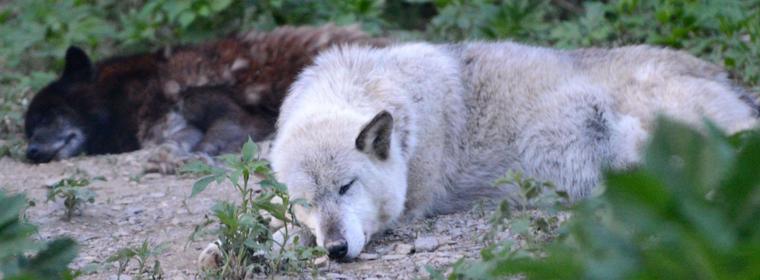
Posted: Saturday, July 25, 2015
The howling is sporadic and sorrowful, a lone wolf pulling back his head and pouring his grief into the sky.
Thor, a 15-year-old gray wolf, lost his mate two days before, and he is keenly feeling her loss. Otherwise, it’s a fairly quiet night at the full moon tour at the Wolf Sanctuary of Pennsylvania, where hundreds of people flock each month to get a close look at the apex predators in a natural — but safe — environment.
But don’t let the storybooks fool you — wolves typically don’t howl at the moon. “That’s kind of a myth,” says Denny Binkley, one of several volunteers manning the enclosures on the June 6 tour. “They howl because they can see to hunt better (under a bright moon). They’re excited, and they call in the pack for the kill.”
Still, he says, there’s something special about seeing the wolves as the sun goes down — and they’re extra mysterious in the dark. “They howl much more during the winter tours, when it’s colder and they’re happier,” he says.
SELF-GUIDED TOURS
Full moon tours are self-guided, Binkley says, with volunteers posted by each enclosure to introduce the wolves and answer questions.
There’s always a bonfire — guests are encouraged to bring hot dogs and marshmallows for roasting — and usually entertainment, from the Southern Heart Singers, the Native American drum and vocal group that performed June 6, to the Edgar Allan Poe impersonator who does dramatic readings in October.
But the stars, of course, are the wolves. “Most of the wolves we have here were rescued from domestic situations,” says Binkley.
On this day, the wolves are lazy, fat and happy after sharing a deer carcass, donated to the sanctuary after it was found dead on a nearby road. It’s more than a fresh meal, Binkley notes. “We give them a deer, they make any number of toys out of it,” he explains. They’ll play with bones and hooves, for instance, and chew the skin into rawhide. Sometimes, he says, they’ll bury part of the deer to find later.
He smiles as, behind him, Merlin cracks his way through a leftover leg bone. Merlin, he says, is one of their old-timers, a 13-year-old eastern timberwolf who shares an enclosure with his offspring, a 9-year-old male named Tioga.
Both wolves were rescued from a property in Shamokin, Binkley says, where they were illegally kept as pets. They’re among 43 wolves and wolf hybrids at the sanctuary, he says — close to two dozen are visible to the public on the general tours, and all of them can be seen on private tours.
Enclosures range in size from 1.5 to 2.5 acres, he says.
DIFFERENT FROM DOGS
Wolves are very different from their canine cousins, says Rosemarie Curcio, another volunteer.
You can’t walk a wolf on a leash, she says. And if you tried to crate a wolf, it could die of stress from confinement.
They aren’t pets, Binkley adds. “Wolves generally are very hard to train,” he says. “Their bite pressure is 1,500 pounds per square inch — twice that of a dog. Their play together is kind of rough. If they play with you like that, they could seriously hurt you.”
They can also be temperamental, he adds. “If you feed them out of order, you can start a pack fight.”
SETTING SUN
On June 6, as the sun sets and the woods grow dark despite the moon, Thor begins howling more often. Loud and poignant, it’s an inescapable voice of bereavement. Curcio cocks her head to listen with her guests as Thor, invisible in the thick underbrush, howls again. “That’s a different sort of howl, a very mournful howl,” she says. “You can hear the difference — and you’ll notice, the other wolves aren’t answering back.”
Thor is blind, she says, but he’s aware that his mate, 15-year-old Lucky, is dead. The other wolves respect his grief by remaining silent. “There’s nothing we can do,” says Curcio. “He has to work it out on his own.”
Up front, Binkley crouches down and howls to try and encourage the others to join in. Mostly, they ignore him ... although Chipper, a wolf-malamute hybrid, whines a bit. He’s probably just hungry, Binkley says.
source
Thor, a 15-year-old gray wolf, lost his mate two days before, and he is keenly feeling her loss. Otherwise, it’s a fairly quiet night at the full moon tour at the Wolf Sanctuary of Pennsylvania, where hundreds of people flock each month to get a close look at the apex predators in a natural — but safe — environment.
But don’t let the storybooks fool you — wolves typically don’t howl at the moon. “That’s kind of a myth,” says Denny Binkley, one of several volunteers manning the enclosures on the June 6 tour. “They howl because they can see to hunt better (under a bright moon). They’re excited, and they call in the pack for the kill.”
Still, he says, there’s something special about seeing the wolves as the sun goes down — and they’re extra mysterious in the dark. “They howl much more during the winter tours, when it’s colder and they’re happier,” he says.
SELF-GUIDED TOURS
Full moon tours are self-guided, Binkley says, with volunteers posted by each enclosure to introduce the wolves and answer questions.
There’s always a bonfire — guests are encouraged to bring hot dogs and marshmallows for roasting — and usually entertainment, from the Southern Heart Singers, the Native American drum and vocal group that performed June 6, to the Edgar Allan Poe impersonator who does dramatic readings in October.
But the stars, of course, are the wolves. “Most of the wolves we have here were rescued from domestic situations,” says Binkley.
On this day, the wolves are lazy, fat and happy after sharing a deer carcass, donated to the sanctuary after it was found dead on a nearby road. It’s more than a fresh meal, Binkley notes. “We give them a deer, they make any number of toys out of it,” he explains. They’ll play with bones and hooves, for instance, and chew the skin into rawhide. Sometimes, he says, they’ll bury part of the deer to find later.
He smiles as, behind him, Merlin cracks his way through a leftover leg bone. Merlin, he says, is one of their old-timers, a 13-year-old eastern timberwolf who shares an enclosure with his offspring, a 9-year-old male named Tioga.
Both wolves were rescued from a property in Shamokin, Binkley says, where they were illegally kept as pets. They’re among 43 wolves and wolf hybrids at the sanctuary, he says — close to two dozen are visible to the public on the general tours, and all of them can be seen on private tours.
Enclosures range in size from 1.5 to 2.5 acres, he says.
DIFFERENT FROM DOGS
Wolves are very different from their canine cousins, says Rosemarie Curcio, another volunteer.
You can’t walk a wolf on a leash, she says. And if you tried to crate a wolf, it could die of stress from confinement.
They aren’t pets, Binkley adds. “Wolves generally are very hard to train,” he says. “Their bite pressure is 1,500 pounds per square inch — twice that of a dog. Their play together is kind of rough. If they play with you like that, they could seriously hurt you.”
They can also be temperamental, he adds. “If you feed them out of order, you can start a pack fight.”
SETTING SUN
On June 6, as the sun sets and the woods grow dark despite the moon, Thor begins howling more often. Loud and poignant, it’s an inescapable voice of bereavement. Curcio cocks her head to listen with her guests as Thor, invisible in the thick underbrush, howls again. “That’s a different sort of howl, a very mournful howl,” she says. “You can hear the difference — and you’ll notice, the other wolves aren’t answering back.”
Thor is blind, she says, but he’s aware that his mate, 15-year-old Lucky, is dead. The other wolves respect his grief by remaining silent. “There’s nothing we can do,” says Curcio. “He has to work it out on his own.”
Up front, Binkley crouches down and howls to try and encourage the others to join in. Mostly, they ignore him ... although Chipper, a wolf-malamute hybrid, whines a bit. He’s probably just hungry, Binkley says.
source


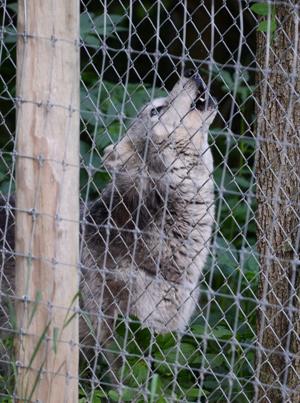
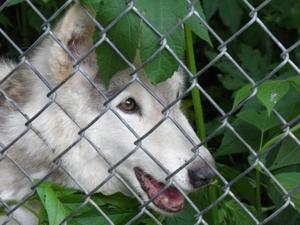
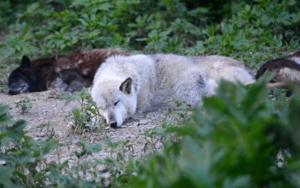
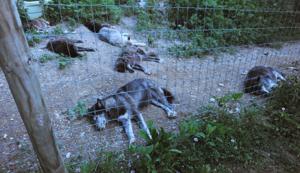
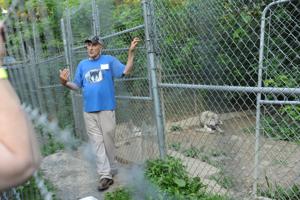
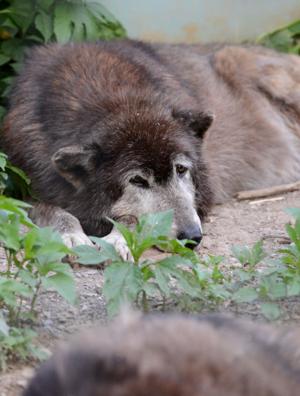
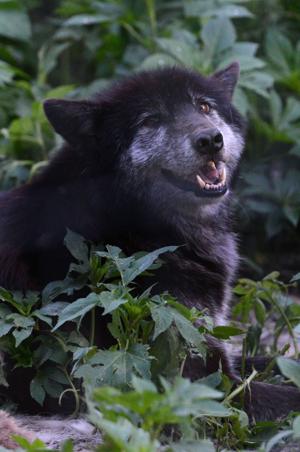
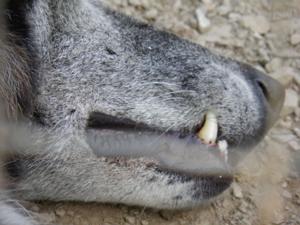
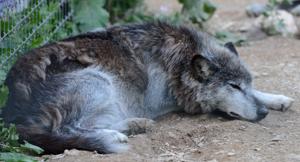

No comments:
Post a Comment